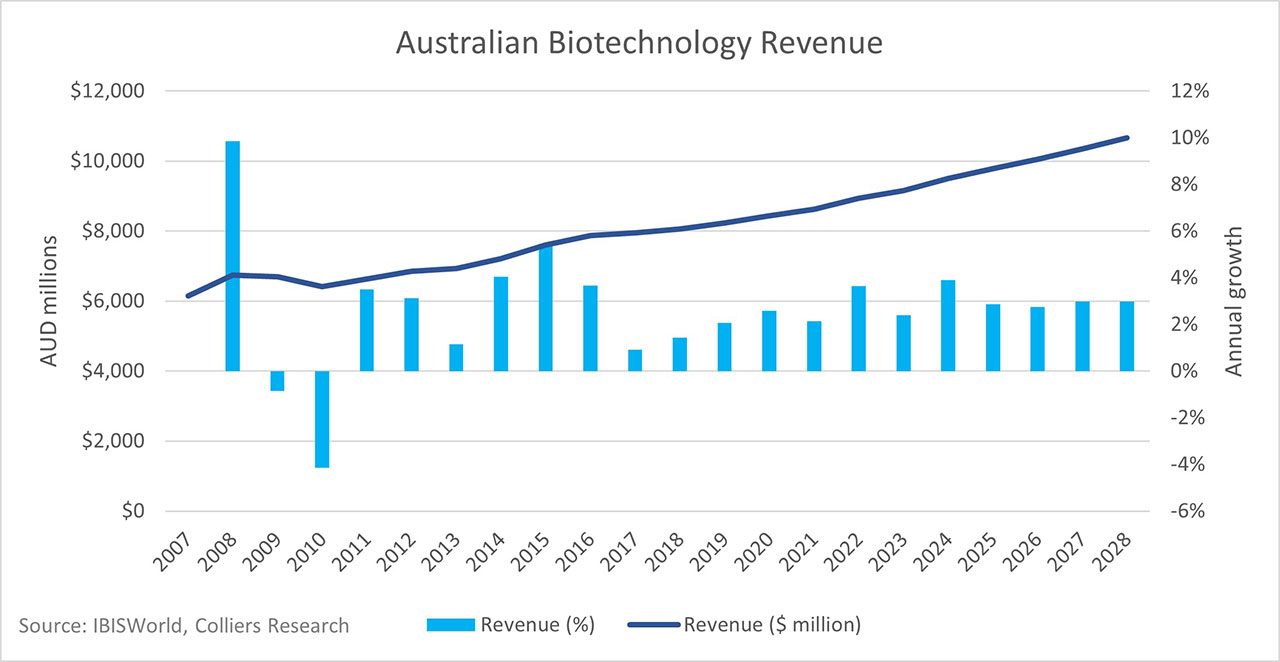This article is from the Australian Property Journal archive
COMMERCIALISATION of life sciences and the sector’s huge capital growth potential are attracting real estate investors, with the sector making up just 2% of the total securitised property market in Australia.
Total assets under management are valued at about $6.5 billion and the total market size is estimated by Preqin to be between $150 billion and $250 billion.
According to a new report by Colliers and Harrison Street, the growth projections for healthcare in general and the life sciences sector, as well as the ageing population and increased private and government investment, are attracting growing interest from venture capitalists and institutional and commercial real estate investors, as the sector’s strong fundamentals offer secure, reliable, and long-term income.
Index performance tracking from the ASX showed that in the listed health sector over the period from November 2010 to June 22, the ASX 300 healthcare sector grew by 319%, outperforming IT and other sectors such as metals and mining and financials.
Real estate and its location are an integral part of the health and life sciences ecosystem, according to the report, and real estate participants are in a unique position to leverage from the growth outlook for this sector. Industry revenue is forecast to grow at an annualised 3.0% over the five years through 2026-27, to $10.3 billion. In the wake of the COVID-19 pandemic, industry operators stand to benefit from government-led efforts to enhance Australia’s sovereign capabilities in the manufacturing of essential medical supplies, including vaccines.
“Due to the specialised requirements needed for both the location – such as being close to hospitals, health institutes and universities – and the type of building required for a life sciences operator including laboratories, R&D space and specialised storage requirements, new purpose-built developments will in many cases be the only option and therefore provide opportunities for real estate investors and developers to capitalise on the growth outlook for this industry, whether through direct development opportunities or fund-through development transactions,” said Joanne Henderson, Colliers’ national director of research, said.
“Also, the clustering effect on the success of health and life science companies has been proven and as such, opportunities will exist for owners of potential development sites within close proximity to existing and planned health hubs surrounding major hospitals and universities.”
PDG is currently developing a $1 billion health and research precinct on the northern edge of Melbourne’s CBD, close to the existing hospitals precinct and University of Melbourne. The project will be the future headquarters of CSL and reached full commitment early in the year with the Royal Melbourne Hospital signing up for 10,000 sqm of space.
The growing weight of capital looking to be invested into the property sector has primarily been driven from superannuation funds, which continue to see retirement savings grow annually, as well as an increase in interest from offshore capital into the Australian market.
The sector also allows investors to support financial and social objectives, diversify their investment portfolios, and provide insulation from broader economic conditions.
“Like many alternative real estate asset classes, many life science companies look to lock in longer lease terms, given the more specialised nature of the space they occupy. Therefore, life science real estate offers a lower risk asset offering a long-term cash flow with reduced levels of rental downtime,” Henderson said. APH Holding has secured government tenant Eastern Health to anchor stage one of its $320 million Wellington Health precinct in Melbourne’s Box Hill on a 40-year term.
“The rise in demand for long weighted average lease expiry (WALE) assets has been apparent over the last two years through the pandemic. Investor interest in long WALE assets is not a new trend, however the current uncertainty has increased focus and therefore competition for these assets,” Henderson said.
“Yields have been driven downwards as a result.”
Ian Sanders, head of transaction services, Asia Pacific healthcare and retirement living for Colliers said that whilst the potential investment universe is large, the requirements for capital can be significant especially when linked to either the initial stages of the life sciences life cycle, or alternatively at the mature end of the spectrum.
“Additionally, if the investments are made at the initial end of the spectrum, there is a significant risk that needs to be carried from an investment lens, until such time as either returns can be achieved commensurate with risk or the risk profile is reduced due to progression through life cycle.”




